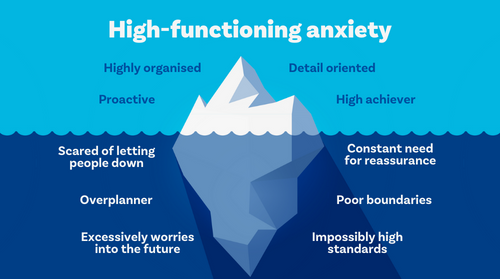
A person sits at their desk with their head in their hands, looking stressed and anxious.
You’re busy but in control. You seem successful to others, but you don’t feel that way. Could it be high-functioning anxiety? Let’s find out.
Anxiety disorders are the most common mental health condition in Australia, affecting 1 in 4 people. Although it’s not an official diagnosis, the term ‘high-functioning anxiety’ can be grouped with generalised anxiety disorder and is something many people with anxiety identify with.
What does it look like?
Someone with high-functioning anxiety can appear well-accomplished on the outside but can be experiencing worry, stress or obsessive thoughts on the inside. They may show the signs and symptoms of anxiety paired with unique behaviours such as:
- controlling behaviour with strict routines and habits
- seeming busy all the time with a to-do list that never ends
- striving for perfection in every area of life
- often being hard to read and relate to.

Signs and symptoms of high-functioning anxiety
Generalised anxiety disorders are diagnosed when you feel intense worry most of the time for more than 6 months. This lingering feeling is overwhelming and impacts every part of your daily life.
These behaviours and feelings are where anxiety can turn into high-functioning:
- worrying about things ahead of time to extremes
- working long hours and always going above and beyond to make sure you don’t make an error
- an intense fear of letting people down
- impossibly high standards that even when reached, don’t leave you feeling satisfied
- feeling safe and stable when you focus on small details
- certain habits like nervous chatter, fiddling with your hair, or cracking your knuckles.
How to deal with high-functioning anxiety
This never-ending loop of stress actually has a loophole when it comes to treatment.
If you’ve been diagnosed with anxiety, there are a range of options available. Medication, cognitive behavioural therapy, and mindfulness training are all in the potential toolkit, but let’s look at some other tips you can try on your own to reduce anxiety.
- Look at lifestyle changes, such as limiting caffeine, nicotine, alcohol, and other drugs, eating a balanced diet and exercising regularly.
- Consider alternative therapies such as yoga, meditation and acupuncture.
- Try to dedicate 10 minutes each day to work on your mental wellbeing.
- Reflect on your thought patterns when the anxiety kicks in. Try challenging them with more helpful thoughts.
- When it comes to managing anxiety, sleep is often underrated. Sticking to a regular bedtime and getting up early to do something you enjoy are great places to start.
- When you feel nervous, find coping strategies such as deep breathing, muscle relaxation, meditation, acupuncture, and yoga.
When to ask for help
It’s normal to feel anxious at times, especially with life’s ups and downs. You don’t need to have a diagnosed anxiety condition to seek help when the going gets tough.
Whether you experience high-functioning anxiety symptoms or have been diagnosed with anxiety, support is available:
- talk to a counsellor, friend, colleague, or family member
- make time to see your doctor
- Lifeline: 13 11 14 or lifeline.org.au
- Beyond Blue: 1300 224 636 or beyondblue.org.au
- MensLine Australia: 1300 78 99 78
- Head to Health: 1800 595 212
- Alcohol and drug support: 1800 177 833
For immediate help contact Triple Zero (000) if it is an emergency.